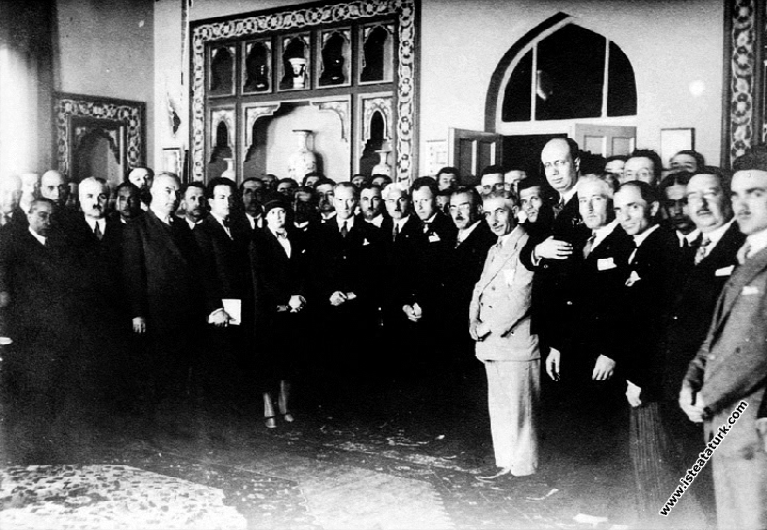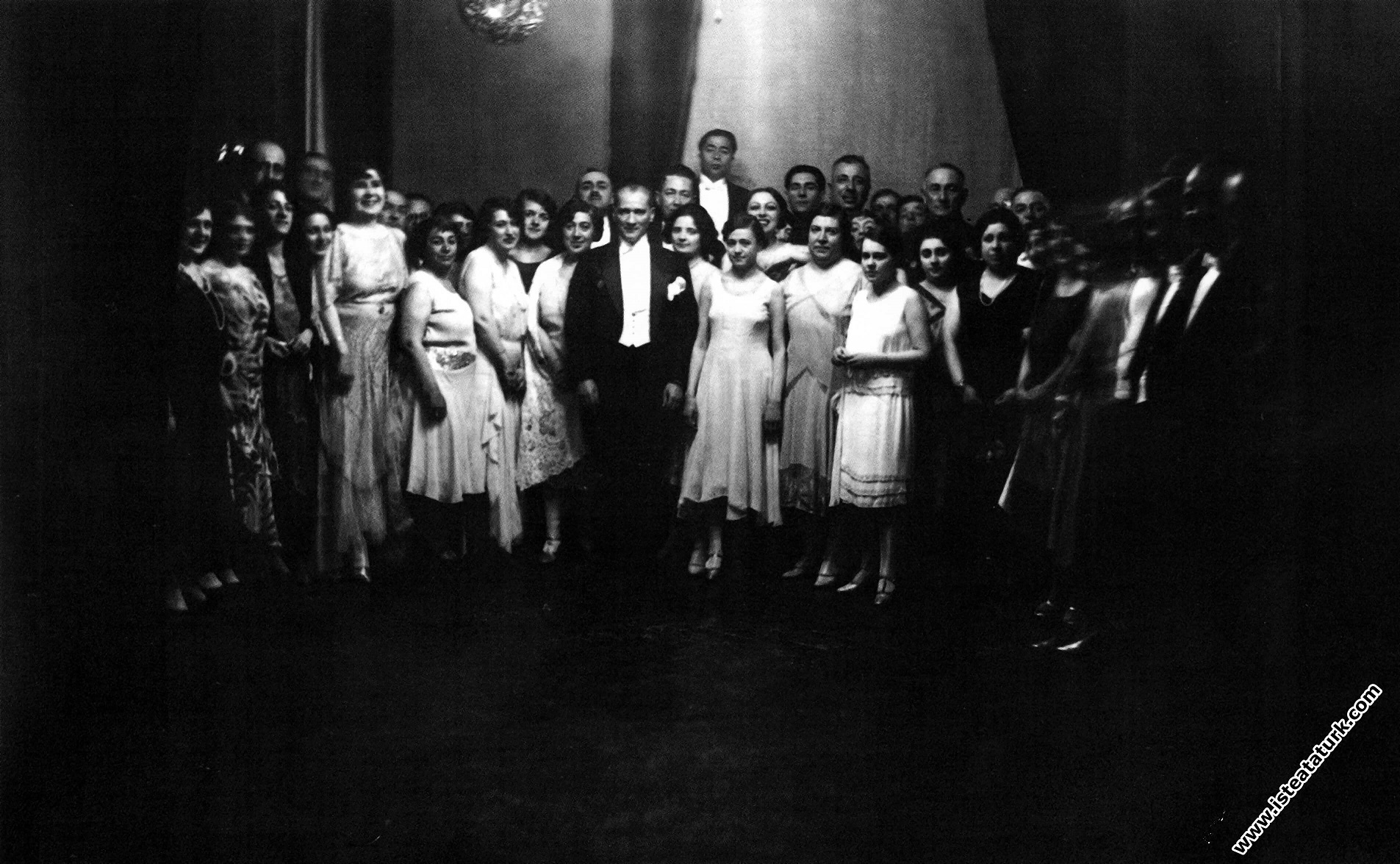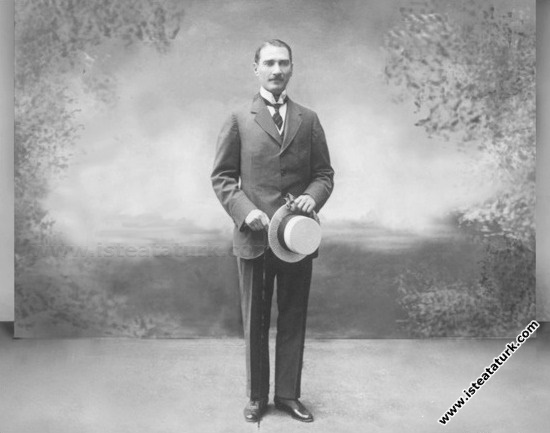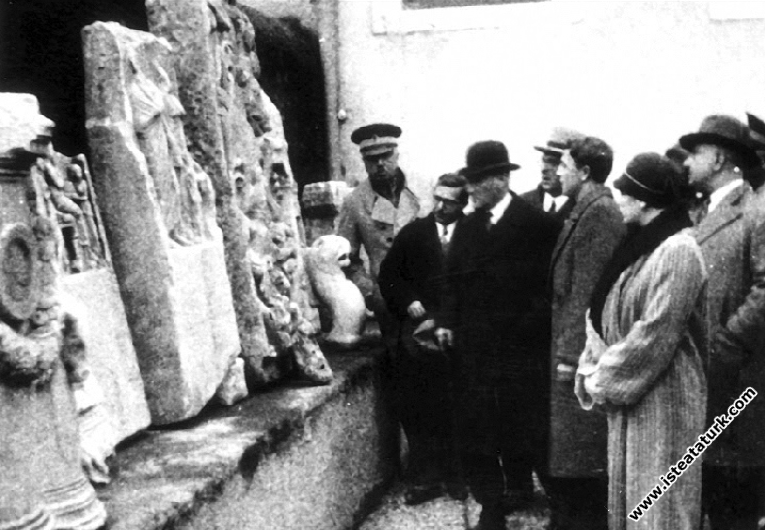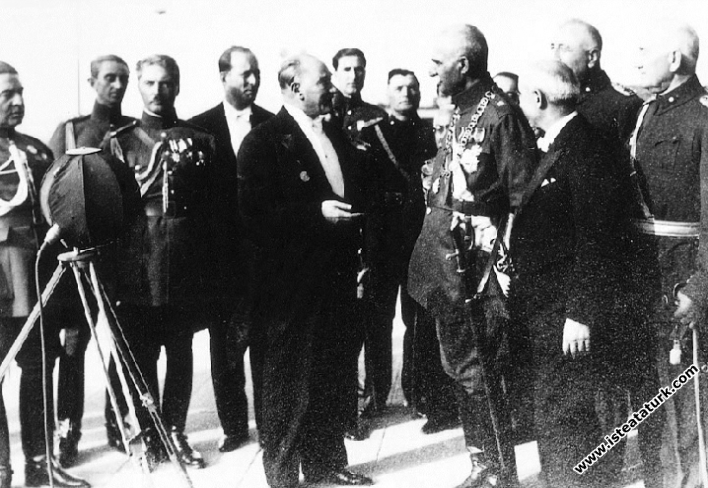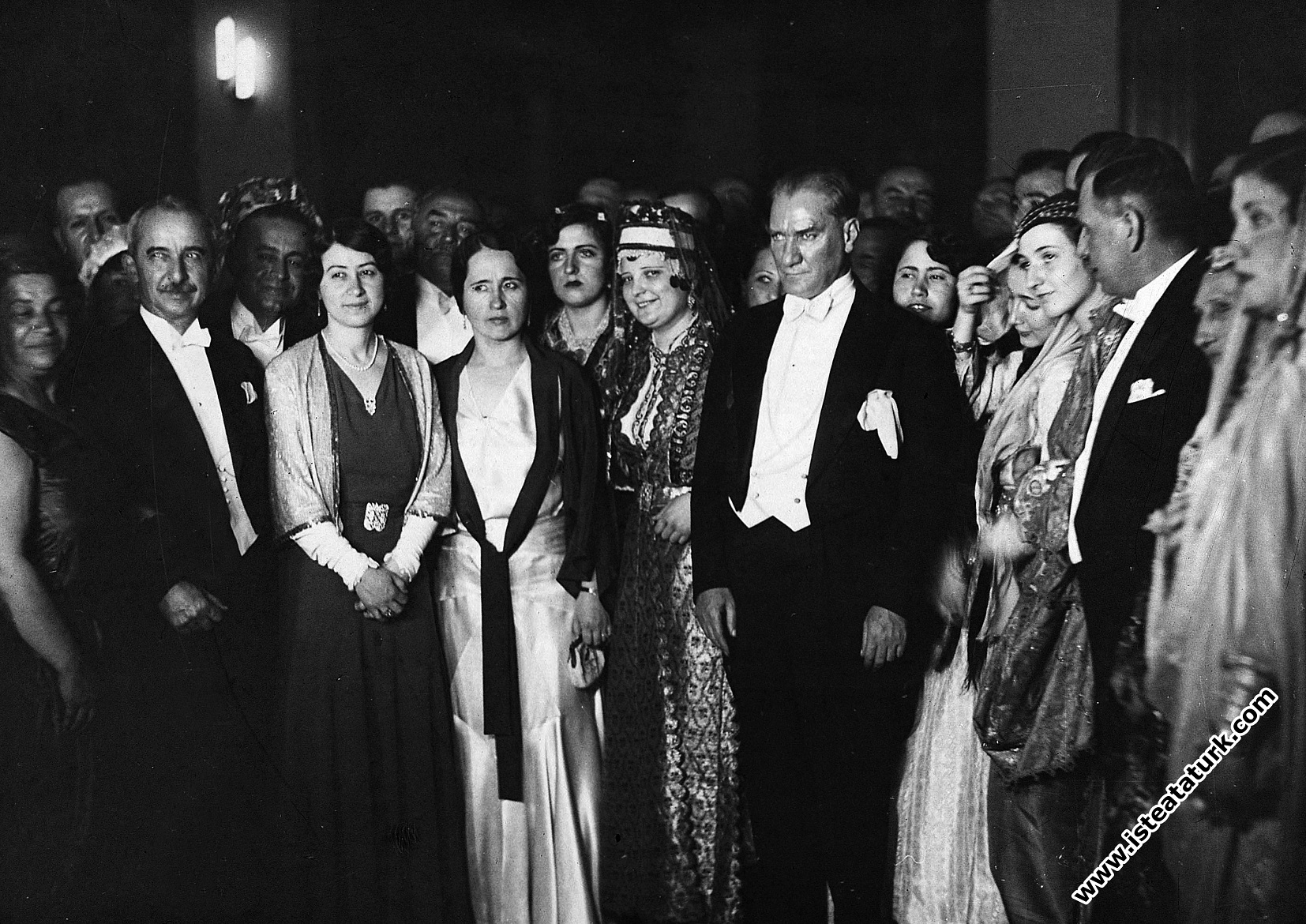
How Was Turkish Folk Culture Benefited in the Theater and Opera Studies of the Atatürk Period?
Character Size
How Was Turkish Folk Culture Benefited in the Theater and Opera Studies of the Atatürk Period?
How Was Turkish Folk Culture Benefited in the Theater and Opera Studies of the Atatürk Period?
Just as Atatürk set the goal of creating "new Turkish music" by compiling folk melodies and processing them according to the latest musical rules, he wanted to benefit from Turkish history, mythology and folk culture in the field of theater and opera.
Atatürk was a president who read a lot and drew useful conclusions for his nation from what he read. He knew very well that mythology, epics and legends were used abundantly in the important works of world theater and opera history, in the ancient Greek theater and in the works of W. Shakespeare, thus creating magnificent works. On the other hand, in front of him stood the theater and operetta legacy of Dârû'l Bedayi with the Tanzimat and Constitutional Period theater. He had the opportunity to get to know a good cultural theorist like Ziya Gökalp. He had also traveled partly in Europe.
In our country, the practices of the idea of benefiting from folk culture in theater were unconsciously started in the Tanzimat and Constitutional Periods. Şinasi in The Marriage of the Poet (1859); He tried to get closer to the folk language and used plenty of proverbs and idioms for this purpose. When the first regular performances started in Istanbul Gedikpaşa Theater in April 1868; Güllü Agop tried the story of Leyla and Majnun in order to attract spectators to the theatre, and made this story a play for Diniüstü Mustafa Efendi. It is an adaptation of 1001 Nights Tales of Recaizâde Mahmut Ekrem's play, "The One Who Knows is Very Wrong," written in 1874.
Among the playwrights of the Constitutional Era, Abdülhak Hamit Tarhan was the one who valued mythology and used it the most in his plays. Tarhan's plays based on mythology, legends and tales and historical events are as follows: Nesteren (1877), Eşber (1880), Zeynep (1908), Garam (1912), İlhan (1913), Turhan (1916), İbn-i Musa (1917), Hakan (1935). He used 73 proverbs and 36 idioms in the play Sabrü Sebat, which he wrote in 1874. Feraizcizâde Mehmet Şakir Evhamî (1885-86) used shadow and middle play types in his play. Musahipzâde Celâl, on the other hand, knew how to consciously benefit from Turkish Folk Literature, folk theater, and our traditions and customs in his plays. This feature is clearly seen in the plays of Istanbul Efendisi (1913-14) and Khashoggler (1920).
After the proclamation of the Republic on October 29, 1923, studies in the field of fine arts were tied to a discipline, as in every field. Darü'l Elhan, Darü'l Bedâyi, Muzika-i Hümayun and Sanayi-i Nefise Mekteb-i Ali, which were transferred from the Ottoman Empire, were restructured and their names were changed. Folk music compilations started (1925). The Music Teachers' School (1924) and the Ankara State Conservatory (1936) were opened in Ankara, giving weight to Western Music education. The training of artists needed in the fields of music, opera, ballet and theater began.
Dürü'l Bedâyi was the center of professional theater studies during the Atatürk period. There were also private theater groups. Muhsin Ertuğrul was appointed as the head of this organization, which was transferred from the Ottoman Empire, in 1927 and great progress was made. The number of female players has been increased. The game repertoire has been improved. As it is known, after Afife Jale, Bedia Muvahhit first appeared on the stage in İzmir (July 1923) at Atatürk's request and acted in films. By enacting the law numbered 1167 on June 25, 1927, it was ensured that no consumption tax was collected from educational performances and concerts. On November 19, 1930, a Theater Vocational School affiliated to Darü'l Be-dâyi was opened and new artists began to be trained. In 1931, the name of Darü'l Bedâyi was changed to Istanbul City Theatres."
In the Atatürk period, the center of amateur theater activities was Turkish Hearths at first, and Community Centers since the summer of 1932. One of the nine branches in the Community Centers was the "Representation Branch". There could be more than one theater group in the representation-theatre branch. According to the People's Houses Working Regulations, it was stipulated that the representations to be played in the branches should be chosen by the CHP administration and that the roles of women should not be played by men.
The Theater Vocational School opened by Istanbul City Theaters in 1930 was not successful. In 1936, a State Conservatory was established in Ankara under the direction of Paul Hindemith. Head of the theater department Prof. Carl Ebert was brought in. He started teaching with three girls (Melek Ökte-Gün, Muazzez Lutas-Kurdaoğlu, Nermin Sarova) and five boys (Ertuğrul Ağırn, Esat Tolga, Mahir Canova, Nüzhet Şenbay, Salih Canar). Until the conservatory artists were trained, teachers and students from the Music Teacher's School, Gazi Education Institute, Girls' High School and İsmet Paşa Girls' Institute were used in the performances in Ankara.
While the infrastructure of theater, opera and ballet arts was being created, the issue of writing and composing new plays and operas came to the fore. Atatürk wanted Turkish history, Turkish folk culture and the new values brought by the Republic to form the source of his fine arts works in the Republican period. For this purpose, he gave the subjects of some plays himself, examined and corrected the texts of these plays like a dramaturg, and was present in their first performances. When Atatürk focused on the subject of history, he had Faruk Nafiz Çamlıbel write the Akın-Özyurt-Hero trilogy, supervised the writing of the Akın play and changed the ending." After the performance of Behçet Kemal's Shepherd play (April 3, 1932); "Theater is the mirror of the cultural level of a country. " he said. Atatürk, Münir Hayri Egeli' i Necil Kazım Akses gave Taş Bebek to Ahmet Adnan Saygun and asked them to compose it as an opera. Atatürk also commissioned Münir Hayri Egeli for the libretto of Öz Soy opera and gave the subject of the opera himself. Combining Turkish and Iranian mythologies and emphasizing Turkish-Iranian friendship and brotherhood, this opera was composed by Ahmet Adnan Saygun and was staged in Ankara Community Center in June 1934 during the visit of Iranian Shah Rıza Pahlavi to Ankara. i Necil Kazım Akses gave Taş Bebek to Ahmet Adnan Saygun and asked them to compose it as an opera. Atatürk also commissioned Münir Hayri Egeli for the libretto of Öz Soy opera and gave the subject of the opera himself. Combining Turkish and Iranian mythologies and emphasizing Turkish-Iranian friendship and brotherhood, this opera was composed by Ahmet Adnan Saygun and was staged in Ankara Community Center in June 1934 during the visit of Iranian Shah Rıza Pahlavi to Ankara.
The first important work in line with the dynamism of creating cultural artifacts stemming from the tradition of Great Atatürk is Faruk Nafiz Camlıbel's Akın play. It is an epic in verse. The subject of Akın is briefly as follows:
In order to end the years of drought in Central Asia, old Hakan Istemi Khan will be sacrificed in accordance with the law. Today, the West and East Beys come to Istemi Khan to fulfill this decree. These three brains' sons are with Hakan so that they can learn the state administration. The three chiefs resort to deception and, as the drought will continue, thinking that it will be their turn to be sacrificed after Istemi Han, they trick the prime minister into killing his daughter Suna instead of Han. Gün Başbuğu's son Demir loves Suna, so he exposes the trick. Because of their arrogant attitude, the people killed three chiefs. Their sons Bumîn, Bayan and Demir became the chief and they dispersed in three directions together with their tribes to realize the "Akın" ideal of Istemi Khan.
Akın was first staged at the Ankara Community Center. Great Atatürk watched the rehearsals frequently and came to his first performance at the Ankara Community Center on the night of January 4, 1932, expressing his appreciation.
Atatürk asked Muhsin Ertuğrul to represent Akın in Istanbul City Theatres. He says he will criticize if it is played badly. Muhsin Ertuğrul plays Istemi Han in the game. On February 11, 1932, Atatürk attends the performance at the Istanbul Tepebaşı Theater with the Governor of Istanbul, Muhittin Üstündağ. Muhsin Ertuğrul's memories of this performance have been published." You are our most valuable artist!”
In the 1930s, many plays were written, taking their subject from Turkish history, civilization, epics and legends, folk culture, virtues of the Republic, its revolutions, and the new values it brought, in line with the purpose determined by Atatürk. We can list the most important of them as follows:
Faruk Nafiz Çamlıbel: Akın (1932), Özyurt (1932), Hero (1933), Fire (1933)
Münir Hayri Egeli: Bayönder (1932), Bir Ülkü Yolu (1932), Taş Bebek (1932)
Behçet Kemal Çağlar: Shepherd (1933), Ergenekon (1933), Attilâ (1935)
Yaşar Nabi Nayır: Mete {1932}, Children of Revolution (1933), Five Revolutions (1933), Honor of the Village (1933)
İbnürrefik Ahmet Nuri Eighth: At the Şeriye Court (1933), Belkıs (1934)
Halit Fahri Ozansoy: Epic of the Decade (1933)
Necip Fazıl Kısakürek: The Seed (1933)
Aka Gündüz: White Hero (1932), Half Osman (1933), For the Gazi Child (1933), Village Teacher (1933), Blue Lightning (1934), He Was a Time (1938)
Abdullah Ziya Kozanoğlu: Kazanoğlu (1932)
Vedat Nedim Tör: Twenty-Nine First Year (1933)
Vehbi Cem Aşkun: The Oguz Epic (1935), An Airplane Day in Atatürk Village (1936)
Reşat Nuri Güntekin: Independence (1933), Tax Thief (1933)
Nihat Sami Banarlı: Red Cagle (1933)
Vasfi Mahir Kocaturk: Yaman (1933)
Peyami Safa: The Sun Is Rise (1937)
Abdulhak Hamit Tehran: Hakan (1935)
Nahit Sırrı Örik: The Unquenchable Fire (1933)
Galip Naşit: Epic (1933)
Ziya Boral: The Living Dead (1936)
Ferit Celâl Güven-Raşit Rıza Samako: Çakır Ali (1937)
Burhan Cahit Morkaya: The Gavur Imam (1933)
Celal Tuncer: The Travelers of the Revolution (1937)
Saim Kerim Kalkan: Homeland and Duty (1938)
Ahmet Naim -Celal Edip: Uzun Mehmet (1938)
Sukru Halil Tugal: Eagle (1936)
Yusuf Sururi Eruluç: Yanık Efe (1936), A Heart's Tale (1938)
Musahipzâde Celâl: Atlı Ases (1936), Köprülü people (1936), Tulip Era (1936)
Aziz Nogai: From tyranny to the Republic (1933), from Sèvres to Lausanne (1933)
Şinasi Okur: Gazi's Way (1935), Woman Saylav (1935)
Naci Tanseli: For Victory (1933)
Yunus Nüzhet Unat: Target (1934), Let's Suna (1938)
Halit Fahri: Ali Baba and the Forty Thieves (1936)
Feyzi Kutlu Kalkancı: Timurhan (1934)
Osman Cemal Carefree: The Üfürükçü (1935)
Necmeddin Veysi: The Sun (Epic, 1934)
Nüzhet Haşim Sinanoğlu: Sakarya (1934), 15 Days of an Officer (1934)
Ali Mustafa Soylu: Cem (1931)
Hüseyin Hüsnü: From Homeland to Homeland (1933)
Kazim Naim Duru: Awakening (1933)
İbrahim Tarık Çakmak: Gray Wolf (1935)
Behzat Butak: Atilla's Wedding (1935), Ana (1936)
Osman Sabri Adal: For the Fatherland (1931)
Fuat Edip Altan: Telling History (1935)
Vedat Ürfi Bengü: Man of the Law (1938)
F. Şemsettin Benlioğlu: Albayrak (1935)
Ahmet Faik Turkmen: Testament (1936)
A. İsmet Ulukut: The Sumerian Pleiades (1934)
Karagoz Games
Ahmet Süleyman: Karagöz's Cleverness (1931), Karagöz's Expulsion from Home (1931), Karagöz's Marriage (1931), Karagöz's Travel to Florya (1931), Karagöz's Intimacy (1931)
Rahmi Balaban: Özdemir Corporal (1938), City or Repentance of Repentance (1938)
Imaginary Little Ali: Dream Curtain (1937)
M.Vasıf Okçugil: Karagöz Güvey (1933), Karagöz Sailing (1933), Karagöz Yalova Pleasure (1933), Karagöz Ahçıbaşı (1933), Karagöz Deli (1933)
Karagöz Kazım: Karagöz Millionaire (1934), Karagöz's Return to Earth (1934)
Karagöz plays were renewed according to the conditions of the day. In line with this understanding, in the following years, İsmail Hakkı Baltacioğlu: Karagöz in Ankara (1940), Ercüment Behzat Lav; He wrote the plays Karagöz Stepte (1940).
Of these plays, Faruk Nafiz's Akın, Özyurt; Behçet Kemal's Shepherd, Attilâ, Ergenekon; Yaşar Nabi's Mete; Münir Hayri's Bayönder plays stem from events in Turkish history before the Ottoman Empire. It exhibited the Turks' being at the forefront in the age of Turkish civilization and aimed to instill the consciousness of Turkishness. Others, on the other hand, took their subjects mostly from the last period of the Ottoman Empire, the War of Independence, Atatürk's life and revolutions. Atatürk is in the foreground in Hero, Istiklal, Blue Lightning, Never-Finding Fire, Red Waterfall, Sunrise and Revolution Travelers. In addition, Hayri Muhiddin wrote a play called Gazi Mustafa Kemal in 1926.
The plays listed above were mostly staged in Community Centers. It was included in the game repertoire of Community Centers. In the 1932-33 season, 511 representations were given in 55 Community Centers in the first year of establishment. This number increased to 1549 representations in 167 Community Centers in 1937. In 1938, we see that a game competition was opened to expand the vocabulary. By 1942, the number of works in Community Center's game repertoire as copyright and translation had reached 77. At the beginning of the most played; İstiklal, Akın, Mavi Yıldırım, Mete, Kahraman, Çoban, Özyurt, Beyaz Kahraman, Kızıl Çağlayan and Kozanoğlu are coming. In addition, plenty of Karagöz and puppet representations are given. In these representations, besides the old plays, some of the old plays were updated and new plays were written.
Atatürk's dynamism to create a work, which takes its subject from Turkish history and folk culture, also gave its first products in the field of opera. Öz Soy (Saygun, 1934), Taş Bebek (Saygun, 1934) and Bayönder (Akses, 1934), the first Turkish operas composed and staged by Turkish composers, emerged under the guidance of the Great Leader. In fact, as we mentioned before, he himself gave the subject of Öz Soy. Atatürk wanted to create a bridge of brotherhood and friendship between the two nations by combining Turkish and Iranian mythologies with his three-act opera Öz Soy. Öz Soy was exhibited in the presence of Atatürk and the Shah of Iran at the Ankara Community Center on June 19, 1934, due to the arrival of Iranian Shah Reza Pahlavi in Ankara. The first performances of the one-act Taş Bebek and Bayönder operas were performed by Atatürk.
The subject of Öz Soy opera, whose libretto was written by Münir Hayri Egeli and consists of three acts and 12 paintings, is briefly as follows: After humans emerged on earth, a conflict began between darkness and light. Finally, the day has come, humanity, captive to darkness, became the subject of Iranian poet Ferdowsi's Shahnameh, and the poet described the darkness that haunts mankind as Dahhak in his work. However, Dahhak, whose persecution has continued for centuries, was overthrown by a hero (Gâve, Bozkurt) who is known by different names in Turkish and Iranian mythologies, gave way to the light, and the people who came to light again chose a "Bey" named Feridun. Feridun had three sons: Tur, İrac, Selm. Tur became the ancestor of the Turanians by dominating all of Asia. Iraj remained in Iran and became an ancestor of the Iranians. Selm, on the other hand, went west and became a father to the Aryans of Europe.
Münir Hayri Egeli, who wrote the libretto of the one-act Bayönder opera, was inspired by Turkish epics and legends. There are three roles in the opera: Bayönder, his wife Izgen and Ozan. The subject of the work is as follows: As a result of a prophecy, Bayönder's wife Izgen will die on a stormy day. One day, an undesirable storm breaks out. Izgen gives Bayönder the golden bowl that he kept in his chest while he was dying. Bayönder drinks from this stone and gives useful services to his nation. When his death approaches, he gathers the greats of his nation and makes a great feast. At the feast, he distributes all his possessions to the greats. The golden bowl also throws the engine. The golden bowl is his ideal. Whenever the Turkish nation is overwhelmed, when they take a sip from the deep, they will find strength as if they had drunk a glass of gold.
The libretto of the one-act opera Taş Bebek was written by Münir Hayri Egeli, inspired by Turkish tales and legends. A doll master gives life to a baby girl he made out of stone. The girl falls in love with the master. However, the baby doll also falls in love with the master's apprentice and runs away with him. Finally, the capricious stone baby becomes loveless and soulless and dies. The baby master realizes that he has made a mistake by trying to create a human.
Necil Kazım Akses, one of the composers of the Atatürk period, from the composer group known as the “Turkish Fives”, 1933; In 1934, he composed Yaşar Nabi Nayır's play Mete as an opera. Ahmet Adnan Saygun, on the other hand, walked the same road in the following years, performing great operas such as Kerem (1952), Köroğlu (1973), Gilgamesh (1983).
Conclusion: A genius commander and a great statesman, Atatürk was also a man of culture. He was a great art lover. He was the chief architect of Turkish culture. its subject; He made important contributions to Turkish Folk Culture by having plays written from Turkish history and Turkish folk culture, by having operas composed and putting them on stage, by training new artists, by establishing Community Centers and spreading his art works throughout the country.
Nail TAN
Proceedings of the 1st International Atatürk and Turkish Folk Culture Symposium
Source: http://ekitap.kulturturizm.gov.tr
